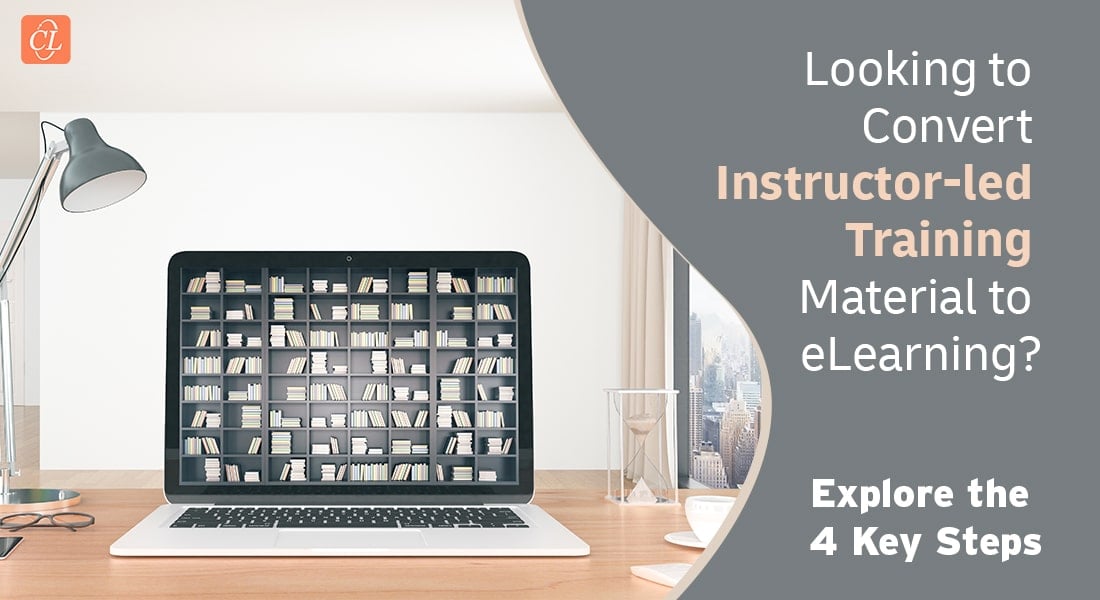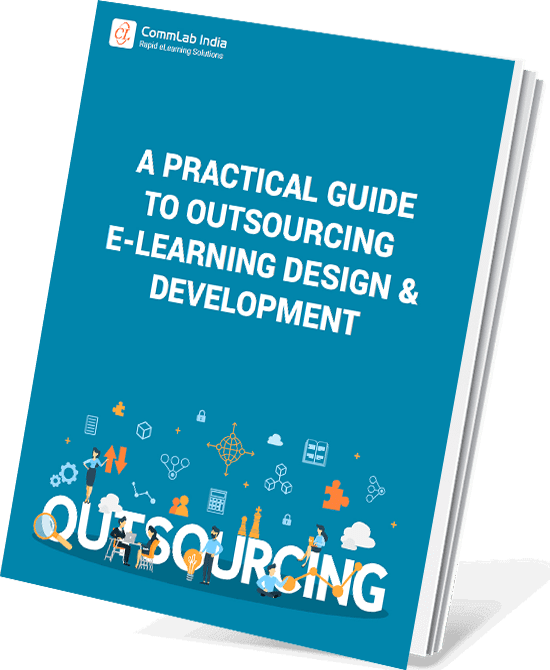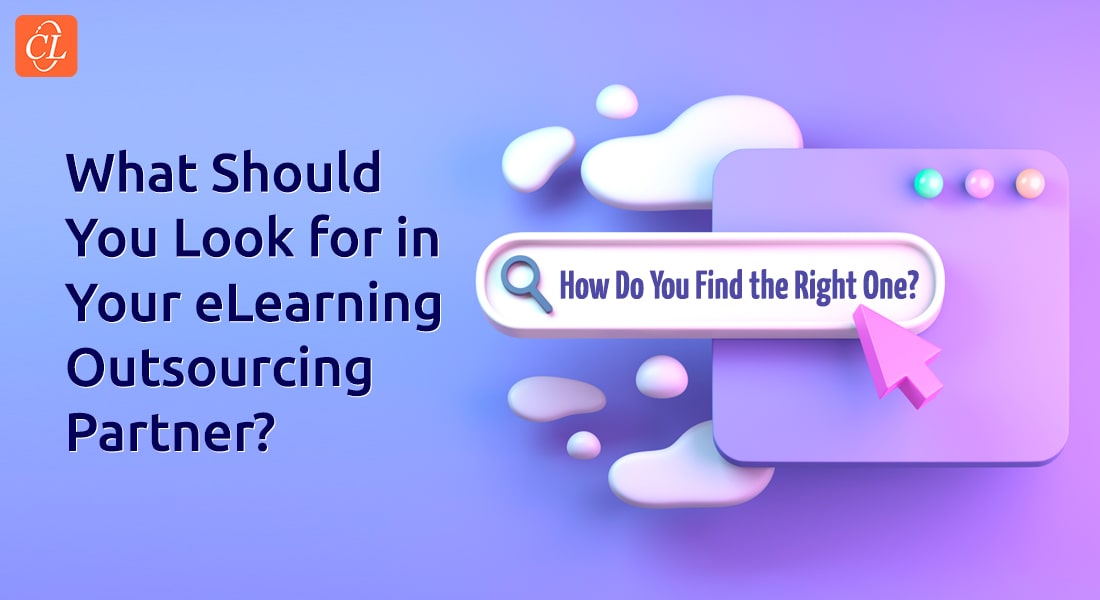How to Convert Your Classroom Training to High-Impact eLearning

If you are looking for an effective eLearning solution to meet the training needs of your geographically dispersed workforce or planning to shift your classroom training to eLearning for seamless and undisruptive learning, then this blog is for you!
In the wake of the ongoing pandemic, many organizations, big and small, are looking to convert their instructor-led training (ILT) material to eLearning courses for effective training. But what needs to be understood is that classroom material cannot be published as an eLearning course by merely importing the material into an authoring tool. E-learning, to be effective, needs to offer substantial engagement and interactivities to draw learners into action and retain their attention throughout the course.
→ Download eBook: Selecting the Right eLearning Vendor
What Does eLearning Design and Development Need?
E-learning design and development requires meticulous planning and demands a great blend of knowledge, experience, and expertise.
It needs:
- Sound instructional design
- The ability to incorporate the essence of the classroom into eLearning
- Expertise in rapid development and authoring tools
So, you have your ILT material in hand and are eager to convert it into an effective eLearning course. What’s next?
What’s next is the 4-step process that will simplify your task of converting your ILT material into high-impact eLearning.
Converting Your Classroom Training Material to eLearning?
Here are the 4 key steps:
- Revisit learning objectives
- Analyze content and fill any gaps
- Devise an appropriate instruction design strategy
- Frame assessments
4 Key Steps to Convert Your ILT to High-Impact E-Learning Course
- Revisit learning objectives
- Analyze available content and fill any gaps
- Devise an appropriate instructional design strategy
- Frame assessments
Let us dive into the details of each step.
Revisit the Learning Objectives
Learning objectives are one of the cornerstones of any eLearning course. They should be performance-based, clear and quantifiable, and must be aligned to the business goals. They should in very clear terms inform the learner on what he will be able to do at the end of the course.
→ Eager to know what’s trending in the corporate training world? Explore the eLearning trends for 2022!
Unlike classroom training, where the learners have the opportunity of interacting with the instructor and fellow learners, eLearning happens in a virtual space with the learner taking the course by himself. Considering the virtual learning environment, it is essential to revisit the learning objectives and reframe them according to the learners’ needs and the learning environment (where the training is going to happen, say shop floor of a manufacturing plant).
A clear understanding of your target audience (their age, language preference, present level of skills and knowledge) and the learning environment can significantly help you to zero down on well-formulated and effective learning objectives.
Analyze the Content and Fill Any Gaps
Once you have defined the learning objectives, the next step is to look at your available content. Collecting and analyzing the content for the eLearning course can be tedious as the content is usually available in multiple formats – PPT decks, PDFs, manuals, facilitator guides, white papers, and so on. Also, the classroom material could be lengthy and might contain outdated or irrelevant information.
That’s why it is crucial for the instructional designer to go through all the available content and identify the content that is relevant for the eLearning course.
And how can you identify the relevant material from the tons of available content?
That’s easy! You retain all the content that is aligned with your set learning objectives. And remove everything else. After that, go through the selected content to check if it is complete and accurate. In case there are gaps (that’s the usual case) or outdated content, take the help of the subject matter expert (SME) to fill those gaps and update content that has become obsolete.
Devise an Appropriate Instruction Design Strategy
Once the core content is in place, you need to think about the instructional strategy. Simply put, an instructional design strategy is a high-level approach of how a topic must be taught to a particular target audience. So, obviously, the instructional strategy depends on:
- Learners
- Learning objectives
- Learning environment
- Type of content
The right instruction strategy motivates and engages the learner and also compensates for the absence of an instructor. You need to retain the essence of the classroom in the eLearning, while still enabling self-paced anytime, anywhere learning.

A Practical Guide to Outsourcing E-Learning Design & Development
Tips and Best Practices for an Effective Outsourcing Journey
- eLearning Elements that can be Outsourced
- Tasks Before Outsourcing
- Tips for Selecting the Right eLearning Vendor
- Ways to Support your Vendor
Popular Instructional Design Strategies:
- Guided learning that uses characters/avatars to guide learners through the course
- Scenario-based learning that places learners in situations where they learn by doing tasks or making decisions
- LEAD (Learning Through Exploration and Discovery) that allows learners to explore and interact with learning elements virtually
- Storytelling that offers immersive learning and enhances retention
- Simulations that mimic real-life environment to allow learners to explore, learn, and practice on a risk-free platform
- Gamification that makes learning fun and motivates learners to complete the training
After the strategy, you need to decide on the amount of audio and the levels of interaction in the course.
Frame Assessments
In the classroom, the instructor assesses learners’ understanding through Q&A sessions or written tests. In e-learning courses, this can be done through:
- Formative assessments
- Summative assessments
Formative assessments are incorporated after each learning point or learning objective to reinforce learning. They are usually followed by feedback. The elearning assessment can be in the form of quizzes, polls, multiple-choice questions, fill in the blanks, drag and drop, match the following, and so on. Formative assessments are not scored.
Summative assessments are planned at the end of the course to assess learners’ understanding of the learning objectives of the course. The assessment determines whether the learner has achieved the learning objectives. They are usually in the form of single select multiple-choice questions. Summative assessments are scored, and learners must achieve a qualifying score to complete the course.
eLearning courses offer the scope for seamless and continuous monitoring of the learning process and for implementing learning analytics with which it is easy to track learners’ progress at any given point during the course.
To Sum Up
Converting your ILT material to e-learning is the need of the hour. Considering the various parameters of eLearning, it might seem challenging initially, but I hope this blog could provide you insights on the intricacies of the entire process. To sum up, if you want to build a robust eLearning course, you must:
- Start with seeing what worked well in the classroom and ensure to have the same level of learner engagement in the eLearning course
- Ensure collaboration between SMEs and instructional designers for quality content
- Ensure your eLearning course is highly interactive to keep learners engaged throughout
If you are looking forward to outsourcing eLearning development for your classroom training materials, here’s a guide to outsourcing eLearning design and development.





![10 eLearning Design Best Practices Every Training Manager Should Know! [SlideShare]](https://blog.commlabindia.com/hubfs/Imported_Blog_Media/elearning-design-best-practices-slideshare.jpg)